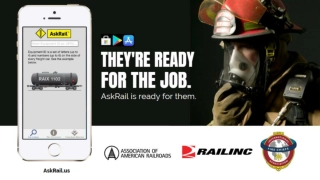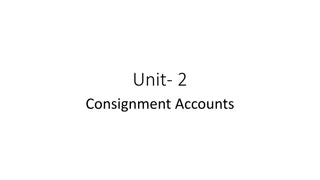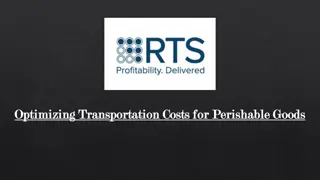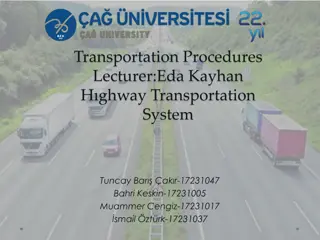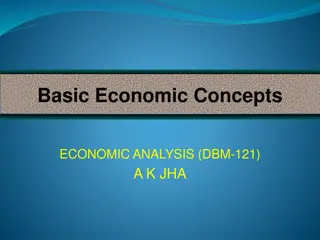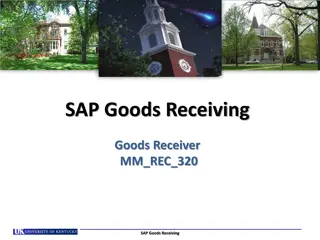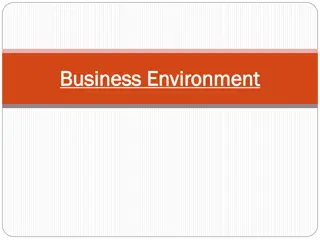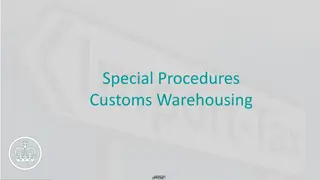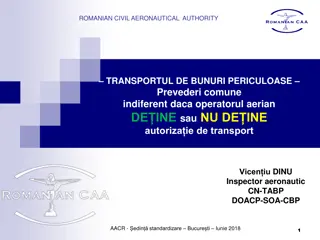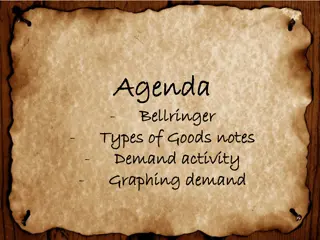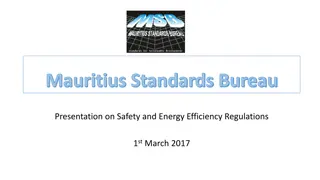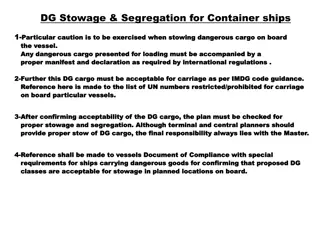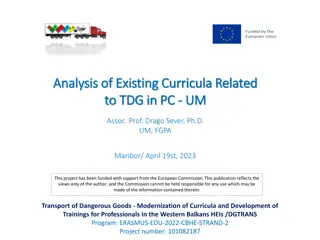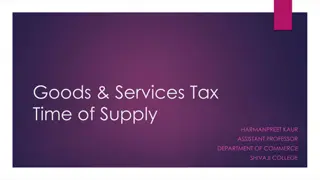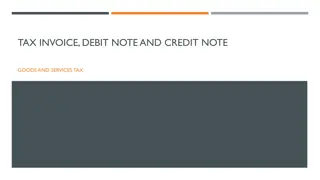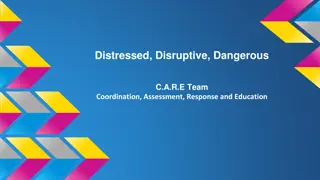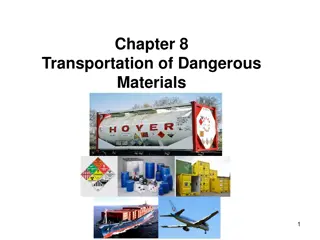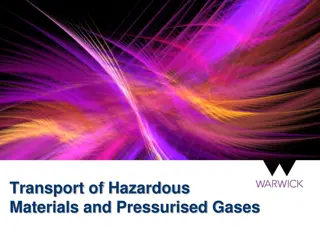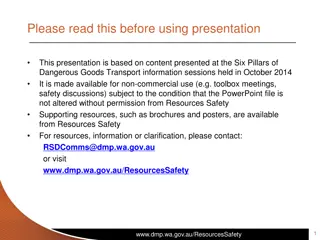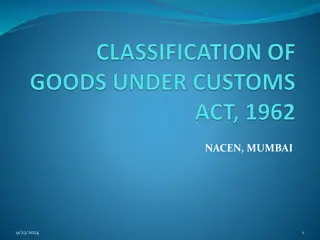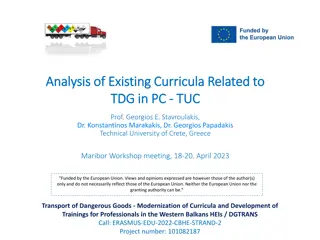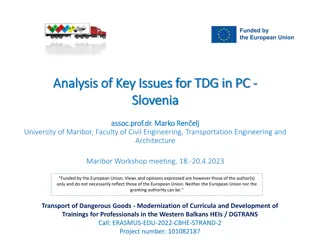Enhancing Rail Safety for First Responders: AskRail App Benefits
Freight railroads annually train tens of thousands of first responders, with the AskRail app developed in collaboration to provide immediate information on hazardous materials, safety marks, and UN numbers. The app assists in responding quickly and safely to rail incidents, offering real-time data o
0 views • 21 slides
Understanding Consignment Accounts in Business
Consignment accounts involve the sending of goods by a consignor to a consignee for sale on the consignor's behalf. The consignor remains the owner of the goods until they are sold, and the consignee sells the goods, collects money from customers, and receives commissions. Various types of commissio
9 views • 22 slides
Factors Influencing Economic Growth: Human Capital and Capital Goods
Factors such as investment in human capital, capital goods, natural resources, and entrepreneurship play a crucial role in determining a country's economic growth. Human capital encompasses the skills and abilities of workers, while capital goods are the tools and equipment used to produce goods and
2 views • 28 slides
ABMN 0511 - RURAL MARKETING
Rural marketing in India involves the flow of goods and services from producers to rural consumers, encompassing demand estimation, product planning, distribution, and ensuring consumer satisfaction. Key components of rural markets include the presence of goods for transactions, buyers and sellers,
1 views • 15 slides
Optimizing Transportation Costs for Perishable Goods
In the realm of logistics, the transportation of perishable goods presents a unique challenge. From fresh produce to pharmaceuticals, these time-sensitive commodities require specialized handling and efficient transportation to maintain their quality and integrity. One of the critical aspects of man
2 views • 6 slides
Understanding the Highway Transportation System
The Highway Transportation System (HTS) encompasses roadway users, vehicles, and roadways with the goal of safely and efficiently transporting people and cargo. The three main components are motor vehicles, roads, and people. Various goods are carried in the HTS, such as container oil, heavy volume
1 views • 27 slides
Understanding Consignment in Accounting
Consignment in accounting involves sending goods from a consignor to a consignee for sale on commission basis. The consignor retains ownership until the goods are sold. The relationship is that of principal and agent, with the consignee handling sales and remitting net proceeds. Important terms incl
1 views • 7 slides
Mastering Desktop Receiving in PeopleSoft eProcurement
Explore the functionality of desktop receiving in the PeopleSoft eProcurement module to efficiently manage goods receipt processes in your department. Learn how to receive, review, sort, and reject ePro goods, along with creating desktop receipts for Office Depot Purchase Orders. Understand the step
0 views • 14 slides
Understanding Basic Economic Concepts: Needs, Wants, Goods, and Services
Exploring fundamental economic concepts such as needs versus wants, goods, services, and products. Learn about the differences between goods and services, types of goods related to income, types of goods related to price, and types of goods related to consumption ability.
0 views • 11 slides
SAP Goods Receiving Training Overview
SAP Goods Receiving training covers the process of confirming receipt of goods or services within a department. It includes roles, training requirements, process flow, transaction codes, and various functionalities related to Goods Receiving in SAP. The training targets individuals authorized to rec
1 views • 52 slides
Understanding Business Environment and Objectives
Business encompasses a wide range of activities related to the production and distribution of goods and services, influenced by various interpretations from consumers, governments, and environmentalists. It involves activities like buying, selling, manufacturing, and service provision, all aimed at
0 views • 61 slides
Understanding Customs Warehousing and Simplified Customs Declaration Procedures
Customs Warehousing is a special procedure that allows goods to be stored in the UK while customs duties and import VAT are suspended. It aims to facilitate trade by providing duty suspension for businesses importing goods from other countries. Additionally, the Simplified Customs Declaration Proced
1 views • 23 slides
In-Bond Manufacturing: A Game Changer in Customs Regulations
In-bond manufacturing allows for certain operations to be carried out on warehoused goods without payment of customs duties, benefiting businesses by facilitating cash flow and ease of doing business. The process involves obtaining permission, following specific regulations, and potentially exportin
1 views • 17 slides
Understanding the Most Dangerous Type of Blood Cancer - Dr Karuna Kumar
Learn about the most dangerous blood cancer: Acute Myeloid Leukemia (AML). Learn its symptoms, treatment challenges, and prognosis in this detailed guide. To know more: \/\/ \/blog\/which-type-of-blood-cancer-is-most-dangerous\/
0 views • 11 slides
Romanian Civil Aeronautical Authority Operation Manuals Overview
The Romanian Civil Aeronautical Authority's operation manuals cover regulations and procedures for the transport of dangerous goods, including general policies, limitations, classification, marking, and labeling. The manuals also address the conditions under which weapons, war munitions, and sportin
0 views • 30 slides
Brexit VAT Treatment of Goods and Services Overview
The Brexit VAT treatment of goods and services impacts cross-border supplies to the UK, VAT refunds for goods, separation provisions under the Withdrawal Agreement, and the Ireland/Northern Ireland Protocol. Changes in VAT regulations and protocols are outlined for businesses and traders within the
3 views • 10 slides
Understanding Types of Goods and Demand in Economics
Explore the concepts of normal versus inferior goods, the law of demand, and graphing demand curves in economics. Learn how income changes affect consumer behavior with examples of goods and services. Understand how to identify normal and inferior goods based on consumer preferences and income level
0 views • 11 slides
Understanding the Installment Purchase System
The installment purchase system is similar to credit and hire purchase systems, allowing buyers to make payments in installments over a period of time. The buyer gets possession and ownership of the goods immediately, but if there's a default in payment, the vendor can't repossess the goods. Instead
0 views • 4 slides
John Finnis' Development of Natural Law and Basic Human Goods
John Finnis' theory of natural law focuses on the development of seven basic human goods, including life, knowledge, friendship, play, aesthetic experience, practical reasonableness, and religion. He emphasizes the distinction between theoretical and practical reason, outlines nine requirements of p
0 views • 14 slides
Understanding the Theory of Demand in Microeconomics
The theory of demand in microeconomics explores the concept of consumer willingness and ability to purchase goods and services at various prices. Factors influencing demand include price, related commodity prices, income levels, consumer preferences, population size, and distribution of income. The
1 views • 13 slides
Safety and Energy Efficiency Regulations Overview by Mauritius Standards Bureau
Explore the comprehensive overview of safety and energy efficiency regulations presented by the Mauritius Standards Bureau on 1st March 2017. The presentation covers important topics such as the Consumer Protection Act, Controlled Goods, Energy Efficiency Act, verification of Certificates of Conform
0 views • 15 slides
Proper Stowage and Segregation of Dangerous Cargo on Container Ships
Exercise caution when stowing dangerous cargo on board container ships. Ensure compliance with international regulations, IMDG code guidance, and vessel-specific requirements. Verify stowage and segregation of dangerous goods, manually check for compliance, and adhere strictly to segregation require
0 views • 13 slides
Understanding Public Goods in Higher Education
This text delves into the concept of public goods in higher education, examining the distinctions between public and private forms, the economic and political dimensions, and the normative value of public goods. It discusses the economic definition of public goods, emphasizing their non-rivalrous an
1 views • 18 slides
Analysis of Existing Curricula Related to Transport of Dangerous Goods in Professional Training Programs
This project focuses on the modernization and development of curricula and training programs related to the transport of dangerous goods (TDG) in higher education institutions in the Western Balkans. It examines the structure of study programs, faculty involvement, and specific programs offered by u
0 views • 23 slides
Understanding Goods and Services Tax (GST) Time of Supply
Goods and Services Tax (GST) time of supply, also known as TOS, determines when GST becomes payable on a supply. This includes various elements like agreement to supply, delivery of goods, provision of services, invoice issuance, payment, and recording of payments. The time of supply for goods and s
0 views • 26 slides
Understanding Tax Invoices, Debit Notes, and Credit Notes in Goods and Services Tax
This content covers the basic concepts of supply, invoicing obligations, tax invoices under Section 28, removal of goods for supply, and scenarios where removal does not result in a supply. Learn about the different types of taxes and when tax invoices should be issued for taxable goods and services
0 views • 28 slides
Important Information on Dangerous Goods Transport
This presentation provides essential details on the Six Pillars of Dangerous Goods Transport, emphasizing the significance of proper documentation, emergency procedures, and regulatory compliance. It highlights the necessity of transport documents for class 6, 8, or division 2.3 dangerous goods, out
0 views • 16 slides
C.A.R.E. Team Coordination for Distressed, Disruptive, and Dangerous Situations
Collaborative C.A.R.E. Team at the university aims to proactively address distress, disruptive behavior, and dangerous situations by supporting students, preventing emergencies, and educating the community. The team includes various leaders from student life, counseling, safety, and more, originatin
0 views • 18 slides
Transportation of Dangerous Materials Regulations
Lab workers handling dangerous materials need to follow strict regulations to prevent accidents. The United Nations and IATA provide guidelines for shipping dangerous goods, with responsibilities for shippers, carriers, and receivers outlined. Classification of dangerous materials and proper handlin
0 views • 9 slides
Understanding Hazardous Materials Transportation Regulations
Legislation governs the transportation of hazardous materials, including strict rules for packaging and transport. Dangerous goods are classified into nine categories, each with specific hazards. Consignors must identify, label, and package goods properly to prevent risks. Biological materials requi
0 views • 9 slides
Understanding Segregation of Dangerous Goods in Transport
This presentation provides valuable information on the segregation of dangerous goods for transport, based on the Six Pillars of Dangerous Goods Transport. It covers topics such as what dangerous goods to segregate, how to segregate them, and includes practical examples. Important examples of incomp
0 views • 12 slides
Enhancing Professional Competencies in Transporting Dangerous Goods
The training aims to develop key competencies essential for safe transportation of dangerous goods, including regulatory knowledge, classification, packaging, labeling, documentation, emergency response, and more. Participants will learn about important practices and methods to ensure compliance wit
0 views • 7 slides
Risk Analysis Methods Related to Transport of Dangerous Goods at Buda University, Hungary
Explore risk analysis methods in relation to Transport of Dangerous Goods (TDG) at Buda University, Hungary. Discover best practices for teaching staff through funded training programs aimed at modernizing curricula and developing professionals in the Western Balkans. Learn about European recommenda
0 views • 30 slides
Guidelines for Harmonized System Classification of Goods
Understand the step-by-step process of classifying goods under the Harmonized System, including referencing section notes and chapter notes, resolving ambiguities in word meanings, identifying essential characteristics of unfinished goods, choosing specific headings over general ones, and classifyin
0 views • 41 slides
Analysis of Existing Curricula Related to Transport of Dangerous Goods in PC - TUC
The analysis focuses on the existing curricula related to the transport of dangerous goods in the context of TUC, highlighting various courses offered by universities in Greece for professionals in the field. The curriculum modernization and training development initiatives in the Western Balkans ar
0 views • 11 slides
Challenges and Trends in the Sporting Goods Industry
The sporting goods industry has faced challenges such as store closures, bankruptcies, and shifting consumer preferences. Sales in sporting goods stores remained relatively stable from 2015 to 2016, but a significant decrease was seen in the first seven months of 2017. Participation in physical acti
0 views • 10 slides
Analysis of Key Issues for Transport of Dangerous Goods in Slovenia
This analysis focuses on the legal bases and regulations governing the transportation and inspection of dangerous goods in Slovenia, covering aspects such as international agreements, EU requirements, specific legislation for different modes of transportation, and the Dangerous Goods Transport Act.
0 views • 11 slides
Modernization of Transport of Dangerous Goods in Poland
Analysis of key issues related to the transport of dangerous goods (TDG) in Poland, focusing on tools, methods, standards, and programs involved in the TDG chain, including the relevant legislation such as the Act on the Carriage of Dangerous Goods and the ADR Agreement. The ADR covers general provi
0 views • 11 slides
Understanding Public Goods and Common Resources
Exploring concepts like private goods, public goods, common resources, free rider problem, Tragedy of the Commons, and cost-benefit analysis in economics, this content helps differentiate between types of goods and resources, providing insights into the challenges and considerations associated with
0 views • 15 slides
The Role of Public Goods in Higher Education
This paper discusses the concept of public goods in higher education, exploring how they are defined, observed, and improved. It analyzes the distinctions between public and private goods based on economic and juridical-political factors, and examines the significance of public goods in advancing so
0 views • 19 slides
